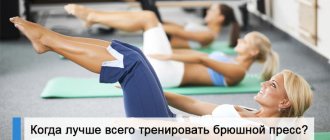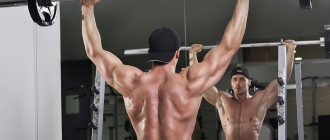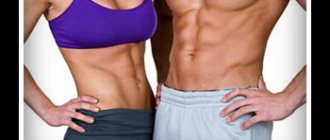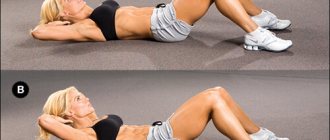Abdominal exercises without putting stress on the spine and lower back
Abdominal exercises are the best way to strengthen your abdominal muscles to reveal those coveted abs, but not everyone can do them.
For example, if you have lower back pain and a sore back in general, you need to exercise your abs with caution. Moreover, some abdominal exercises are strictly prohibited, as they can lead to exacerbations. What exercises should you avoid?
If you have a sore back, we advise you to avoid certain exercises. A striking example is lifting straight legs with an emphasis in a machine or on a bench. Movements are dangerous with lower back pain, as they create a high load on the lumbar spine and intervertebral discs. The spine experiences the greatest load precisely at the moment the legs begin to lift.
If you regularly perform such exercises with a sore back, microdamage will occur in the discs and a hernial protrusion may occur. In the long term, this threatens the development of osteochondrosis.
Another harmful abdominal exercise for back problems is folds or books. It has many names, but the essence is the same: simultaneous lifting of the legs and torso. In this movement, bending the back places a lot of stress on the spine.
Every specialist will confirm that you need to exercise your abs with back problems with caution, taking into account certain restrictions. For example, when pumping your abdominal muscles, you cannot do crunches with straight legs. To reduce the load on the spine, you need to bend your knees.
You cannot perform any sudden movements when pumping the press, and any loads must be increased gradually. For lower back pain, you need to choose exercises in which the pelvis will always be pressed to the floor or bench, and not hang in the air.
If you experience discomfort in your lower back or back, stop exercising and see a doctor. It is better to play it safe once again, but to avoid the development of dangerous and difficult to treat disorders.
Now let's move on to exercises without stress on the spine. There are not many of them, but for the development of abdominal muscles it is enough:
— Unlike lifting legs with emphasis, hanging exercises on a bar are not prohibited with a sore lower back. This is a basic exercise that helps you work your abs deeply.
- Plank. It can be performed for back pain, but do not overdo it. The main thing is to focus on the forearms, and not on the palms on straightened arms. The wider your legs are, the easier it is to perform the exercise.
- Side plank. It is performed similarly to the classic one, but you must turn your body perpendicular to the floor, placing emphasis on one forearm.
- Twisting on the floor. They must be performed with your knees bent at right angles.
— Twisting on a fitball. This is also an effective and spine-safe abdominal exercise. Lie on your back on the ball with your feet shoulder-width apart and your arms behind your head or crossed over your chest. Keep your body parallel to the floor and begin to twist.
Exercises with a gymnastic ball for the press are suitable even for those who have not previously engaged in fitness. Fitball is even used as a complex therapy for rehabilitation after injuries.
When is it contraindicated to pump up your abs?
There are situations when, with a sore back, any abdominal exercises are prohibited. Acute contraindications include:
- A period of exacerbations that requires complete rest from the patient.
— The final stage of the disorder, requiring surgical intervention.
— The occurrence of pain or discomfort during training.
It is better to wait for remission and start doing light abdominal exercises without putting stress on the lower back and spine, which we discussed above.
The benefits of abdominal exercises are undeniable, and they affect not only the improvement of the body’s muscular corset, but also the strengthening of the ligamentous apparatus of internal organs. But at the same time, there really are certain risks of overstraining the back muscles with the appearance of pain, especially if the technique of lifting the legs and pelvis is violated.
And of course, special care must be taken if there are existing problems in the spine; It is important to wait a few weeks after a treated exacerbation before starting exercise. In this case, exercises should begin with static ones - for example, using the Pilates pose, as well as tightening the pelvis and iliopsoas muscles; gradually moving on to dynamic exercises - twisting.
Considering that the most common cause of back pain that can appear when performing abdominal exercises is pathology of the spinal discs, if pain appears in the background, it is necessary to consult a doctor, undergo MRI diagnostics of the spine, and seek the help of restorative measures - taping, nuclear magnetic resonance -resonance therapy MBST, which in the shortest possible time and without medication will not only eliminate pain, but also restore the integrity of the discs and ligaments in the spine.
Source
Let's start with the most important things
We won’t bore you and in a telegraphic style, we will briefly, or almost briefly, describe the most necessary facts that you should know before you start pumping your abs:
- There are 4 main muscle groups of the abdomen: the transverse abdominis muscle, the internal and external obliques, the rectus abdominis muscle, which is what we call the abs . Although different exercises engage the abdominal muscles in different ways, there is no such thing as “top” and “bottom” abs. During the exercise, the entire rectus abdominis muscle is stimulated at once.
- The main “secret” of the relief press: even if you pump this muscle perfectly, correctly and super effectively, you will not get more sculpted abs than heartless genetics can offer you.
The fact is that the volume (relief), the number of cubes and their appearance depend on the structure of the tendons that divide the rectus muscle into “cubes” (connective fibers, crossing the muscle across, create those same cubes) and on the thickness of the muscle wall - more details in this article .
- It’s unlikely that this is still a secret for anyone, but still: The visibility of your six-pack primarily depends solely on the thickness of your belly fat layer.. There is little of it - the abs are visible, a lot of it - the abs are “embarrassed”.
There is a popular expression in the fitness community: abs are made in the kitchen, not in the gym. This means that you need to adjust your diet and get fewer calories from food than you expend .
- Local fat burning does not exist , so for the purpose of losing weight specifically in the abdominal area, abdominal exercises become useless. They are needed functionally to develop muscles, but not for weight loss.
- For girls, abdominal exercises can even turn into a cruel joke: hypertrophied “oblique” abdominal muscles will increase waist size .
When we have understood the most important points regarding the abs, it’s time to move on to harmful and dangerous exercises!
Is it possible to pump up your abs if your back hurts?
There are cases when straining your muscles is definitely not recommended. This includes acute conditions of any origin (including inflammatory diseases). In such situations, the patient needs to lie in bed and follow the doctor’s recommendations for treatment. As the condition improves, passive physical therapy exercises are introduced into the regimen, for example, light stretching. It is unacceptable to pump the stomach if the disease requires surgical intervention.
In other cases, training the abs is not only allowed, but also recommended. A large belly forces the lower back to strain more than required to maintain balance when moving, which further contributes to muscle fatigue. Therefore, measures aimed at eliminating excess weight and strengthening the abs will have a beneficial effect on the condition of the back.
If, with tense abs, the lower back begins to cramp, you should stop doing the exercise. For mild discomfort, you should wait until the pain subsides, and then continue exercising, choosing lighter loads.
Basic rules and recommendations
Incorrect technique of certain exercises in the gym or at home often causes back pain even in healthy people. When performing crunches - one of the most effective exercises for working out the abs - practitioners often make mistakes. When a person rounds their back when lifting their torso instead of keeping it straight, the spine is further strained. Another mistake is to lift the body too high: in this case, the exercise loses much effectiveness and overloads the lumbar muscles.
On the subject: Techniques for training the press at home
To effectively pump up your abs, you need to provide the greatest work to the rectus and oblique muscles. For this, a slight lift of the body is enough. In this case, the head should not touch the floor when returning to the starting position, and the lower back should not come off. To ensure the latter condition, the legs need to be bent at a right angle and placed on a chair, crossbar or large fitness ball. The goal is to give work to the abdominal muscles while minimally straining the lower back and spinal column. You can also pump up the oblique muscles through lateral twists, as long as your back does not hurt. “Folding into a book” with parallel lifting of the body and limbs is prohibited during dorsalgia - it puts a lot of stress on the spine.
If there are no difficulties when working out cubes on a Roman chair, it is not recommended to immediately move on to exercises with weights. If the back muscles are not sufficiently trained, this greatly overloads them. Muscle microtraumas provoke discomfort in the lower back. Getting carried away with weights without preparation can lead to disc displacement. If you have a bad back, pumping your abs in this way is strictly contraindicated. Healthy people need to first strengthen their muscles with simpler exercises for 2-3 months, and then move on to working with weights.
When performing gymnastics with a sore lower back, you need to follow the recommendations:
- preference is given to exercises in which the lower back and pelvis are pressed against a horizontal plane (bench or floor);
- movements should be smooth and slow;
- start with a small number of repetitions and increase it gradually;
- do not get carried away with straight leg lifts while lying on your back: this movement creates a high compression load on the discs;
- If sharp pain occurs, stop training and inform your doctor;
- Regularly monitor the condition of your sore lower back.
Exercise in the gym may correlate with the severity of hernias if the formation pinches a nerve and provokes neurological symptoms. Such patients need to coordinate a set of exercises with their exercise therapy instructor. The rest should remember that hernias measuring 3-4 mm are recorded on MRI in many middle-aged and older people and in most cases do not lead to dorsalgia.
Lower back pain is more often associated with mechanical damage due to excessive or improper load on the muscles and ligaments. At risk are men whose profession involves lifting heavy objects. Strengthening the muscle corset with correct and dosed exercises plays a decisive role in maintaining working capacity.
A set of effective and safe exercises
If you want to do abdominal exercises without putting stress on your lower back, exercising with a fitness ball is perfect. It can be used for traditional crunches, smooth bends and other movements. If you don’t have a ball at hand, you will need a stool or chair to exercise at home: place your legs bent at the knees on it when working out your abs from a supine position.
It is recommended to perform the complex after a light warm-up with smooth turns of the body left and right:
- Classic plank with support on the forearms. To make it easier to perform, it is recommended to spread your legs wider. Starting position: kneeling. Bending over, place your forearms and elbows shoulder-width apart on the floor. One leg is extended and rested on the floor with the toe down. Do the same with the second one. The spine, neck and legs should form a linear straight line. The support is made up of socks and forearms, the gaze is directed straight ahead. You cannot raise your pelvis higher. Start by staying in this position for 2-3 seconds and gradually increase the duration. It is advisable to distribute body weight so that most of it falls on the forearms, and not on the palms. Exit the position by placing your knees on the floor. It is not recommended for use in cases of radicular syndrome and complicated hernias.
- Side plank. It differs from the traditional one in that the body in the final position rests on only one forearm and is at a right angle to the floor, being turned to it with one side.
- Turns with the ball from a standing position. The fitball is held in hands extended in front of you. Without changing the position of the legs, the body is turned left and right. The greater the mass of the ball, the more the press is loaded. Start with 10 movements in one direction and the other. In the absence of negative symptoms, their number is increased by 2 every week.
If there are no contraindications, you can complete the complex by hanging on the horizontal bar. 1-1.5 hours after training, it is recommended to eat a light protein meal - this will provide the body with substances to strengthen muscle fibers.
Training abdominal abs for back pain outside the acute phase will help strengthen the muscle corset, but the correct technique for working the muscles is important, especially when doing crunches.
Source
LiveInternetLiveInternet
Pumped up abs are the dream of not only many men, but also some women. They go with this dream to the gym, to a fitness center, or work out on their own at home. They train until they sweat, they give it their all, but there is no result. Instead of sculpted abs decorating the torso, there are aching muscles, aching joints and headaches. Fitness trainers named the most common mistakes when pumping the press.
Incorrect execution
It often happens that as a result of improper training, even more problems appear than before. If you do exercises for your abs and abdominal muscles and experience pain or fatigue in your back, this is a signal to you that something is going wrong. In the video we will look at the popular abdominal exercise “twisting” and one of the most common mistakes when performing this exercise, which instead of abs will lead you to a herniated disc, titanium hip joints, scoliosis...
The abdominal muscles bend the torso. More precisely, with a fixed spine and pelvic girdle, the rectus abdominis muscle lowers the ribs, pulls the chest down, and bends the spine. Hence the conclusion - when performing the exercise, you should be focused on exactly these things: maximum flexion of the spine in the thoracic region, which, in fact, sets the trajectory, the downward movement of the chest, i.e. to the pelvis when performing crunches.
Important! Avoid lifting your lower back from the surface you are lying on. Maximum contraction of the abdominal muscles occurs when the upper back is rounded. Focus on moving your ribs towards your navel. Lift your chest literally a few centimeters - this is enough to tense your stomach. Imagine holding an apple between your chin and chest throughout the curl. This will ensure the correct position of the neck. You can also cross your arms over your chest or place your fingers around your ears with your elbows pointing forward.
Crunches are not sit-ups. When you go too high, you transfer the load from the rectus abdominis to the hip flexors.
When performing twists, there is no need to strive upward; the movement should be directed forward and towards maximum flexion of the spine. The straighter your spine is when performing this exercise, the less stress on the rectus abdominis muscle.
Make sure your movements are smooth. At the end of each twist, rest your back on the floor. Slow down before doing the next rep.
Overzealousness
This is a beginner's mistake. They so want to get pumped up abs quickly that they are ready to train for several hours in a row, looking at the abdominal area every 5-10 minutes to see if the coveted abs have already appeared? This approach has two ways of developing events. First: severe overexertion as a result of long workouts, nausea and even vomiting during or after exercise, which appears due to excessive stress on the digestive system, poor health in general.
Second: having given his all and wasted his ardor in 2-3 workouts and suffering from muscle and joint pain, the beginner loses interest in training, comes up with reasons for skipping them, justifies his reluctance to continue doing urgent things and, in the end, gives up the idea of pumping up his abs.
For high-quality muscle growth, a gradual increase in load . From one workout to another. If you increase it too often and sharply, then very soon you will notice that the muscles do not increase at all, but the energy rapidly decreases, lethargy, apathy, depression sets in - all signs of classic overtraining.
Improper breathing
This is one of the most common mistakes. People, while pumping up their abs, do not pay attention to how they breathe, meanwhile, only with proper breathing can you achieve a positive result in a short time and practically without experiencing pain in the joints and muscles after training. Most often what happens is this: a person holds his breath for 4-5 ascents, after which he greedily gasps for air, takes a deep breath and again does not breathe during several ascents.
But muscles need oxygen, especially during training. Without it they cannot work fully. Yes, muscles are a real factory for processing fat and burning calories, but it needs raw materials. In this case, oxygen plays its role. And if raw materials arrive intermittently, the entire work process stops. All movements have zero effect. Or even with a minus sign. How to breathe: at the moment of relaxation - inhale, and at the moment of maximum tension - exhale.
This breathing rhythm will seem difficult at first. You will have to strictly control yourself. After 2-3 workouts, proper breathing will become the norm.
Exercise immediately after eating
This mistake is often made by those who, in addition to pumped up abs, also want to remove a few centimeters from the waist. People think that the calories received by the body during a heavy lunch eaten immediately before exercise will somehow miraculously disappear during training, which means they will not be deposited as a layer of fat. This is wrong. Training with a full stomach will lead to nausea, profuse sweating, arrhythmia, and headache. With intense movements, intestinal volvulus is also possible.
However, it is also harmful to exercise on an empty stomach. The optimal solution is to eat a meal rich in natural carbohydrates half an hour to an hour before training.
Monotonous press swing
The most famous abdominal exercise is lying on your back, hands clasped at the back of your head, knees bent, head pulled up. Unfortunately, this exercise only trains the upper (front) abdominal muscles. While the oblique and lower muscles remain unused. You can’t pump your abs monotonously, training some and ignoring other muscle groups . Exercises should be different. The coach will tell you which ones exactly.
If we are talking about independent training, you can download video lessons of abdominal exercises from professional trainers from the Internet and conduct classes in accordance with their recommendations.
Leg fixation
Almost always, when doing abdominal exercises, people fix their legs in a stationary position (under a bench, in special loops, ask someone to hold them). This is believed to promote greater concentration on the abdominal area. This is a misconception. If the legs are fixed, the thighs begin to work powerfully, not the abdominal muscles. To avoid this mistake, it is better to perform swinging movements on an inclined bench without fixing your legs . In this case, the abdominal area will actively work. If you take into account the mistakes discussed above and adhere to the basic rules when working on your abs, then you will be able to avoid excessive loads, pain and injuries, and most importantly, you will be able to effectively work on this muscle group, which will allow the time spent on training not to be wasted.
A few rules
Do you want to have a flat stomach? Then you must adhere to the following rules when training your abs:
✔No need to pump up your abs to burn belly fat. Getting rid of fat is, first of all, maintaining proper nutrition. Cubes are the result, first of all, of a diet aimed at burning fat. And only in the second - abdominal exercises. Sorry, but local fat loss only happens in commercials, don’t take it as wishful thinking. You won't burn more waist fat by doing more reps of abdominal exercises periodically! Unfortunately for many exercisers, they have to go on a strict diet and/or do cardio work to burn fat throughout their body. But don't 100 sit-ups count as cardio? No. These 100 repetitions will burn fewer calories than a small apple. The best strategy is to gradually reduce calories (100-200 calories per day every three weeks) and/or increase the aerobic component of your workouts. This way you will gradually remove fat from your waist. When your body fat percentage drops below 10%, you will see your abs. If you want the cubes to stay in place even when you're relaxed, you need to increase this figure to six percent. For most exercisers, this means reducing calories in even smaller increments every 2-3 weeks until the daily caloric intake drops to 2,000 calories. If your body fat percentage is still unsatisfactory, you should increase your aerobic activity and/or use fat-burning supplements, which can speed up your metabolism and sweep away the last remaining fat from you. The lower your body fat content becomes, the more difficult it is to continue losing weight. But don't give up. With some persistence, the right training program and methodically reducing caloric intake, you will get sculpted abs and will be rewarded with admiring glances from others.
✔There is no need to do several exercises separately for the “lower” and “upper” abs. Anatomically, the rectus abdominis muscle is not divided into upper and lower, but is ONE muscle. A couple of abdominal exercises and changing them periodically are enough.
✔Don’t make it easier for yourself with jerks. The exercises are performed quite smoothly; the downward movement (of the legs or torso) should also be controlled.
✔If you want muscle growth, follow the same principles as when training other groups, namely, you need to increase the load (weights), you need time for recovery, you need an adequate number of repetitions in the approach and exercises for this group. You don't have to do 5 heavy abdominal sets every workout.
✔Remember that exercises for the lateral abdominal muscles (any exercise in which the torso bends to the side and rises from this position) lead to an increase in these muscles (and not to fat burning in the waist area) and, accordingly, to some widening of the waist. Is this what you really wanted when you started doing dumbbell curls? Based on materials from fashionstylist.kupivip.ru
See also:
Abdominal training: trainer's advice
How to do abdominal exercises correctly
We pump up the press according to all the rules
Is it possible to pump up the press with an intervertebral hernia?
Abdominal pumping is the fastest way to strengthen the muscle corset in the lumbar region and reduce the volume of the abdomen. People with spinal problems are not suitable for such loads.
Is it possible to pump up your abs with an intervertebral hernia? It’s difficult to answer with certainty. In each specific case, the final decision is made by the attending physician, based on the age and individual characteristics of the patient.
Osteochondrosis, protrusions and hernias most often form against the background of increased loads on the spinal column. In this case, two extremes are observed: a weak muscle corset and excessive loads are equally harmful to a weakened body.
In order to strengthen the muscles, they need to be pumped up, and improper distribution of the load is fraught with a destructive effect on the tissue in the area of the intervertebral discs.
General rules
Any doctor will tell you that pumping up your abs without putting stress on your spine is possible if you follow certain rules.
You should remember the restrictive recommendations for people with spinal problems:
- It is strictly forbidden to pump up the press from a lying position with straight legs. Raising the torso occurs due to the iliopsoas muscles, which connect the hips through the pelvis to the lower back. People with back problems may experience flare-ups;
- Do not overuse raising straight legs and body from a lying position. In this case, a significant compressive load occurs on the lumbar region, which causes microdamage even in normal discs;
- The technique of twisting and jumping helps to get rid of excess deposits, but at the same time it negatively affects the lower abs, as well as the internal muscles of the abdomen and pelvis.
Thus, sudden movements, regular stress on the lower back, and bending the back at an angle above 90 degrees should be avoided.
To get rid of pain in the spine during abdominal exercises, you should follow these recommendations:
- The task of the muscles located in the abdominal area is to keep the pelvis, spine and hips in a stable state. The main activities should be approached immediately after warming up;
- Abdominal exercises without stress on the spine include stretching, backbends and push-ups. You should train at a slow pace, avoiding any discomfort;
- Loads should increase gradually;
- You need to take care of a healthy back around the clock. Even while in the office, you need to keep your back straight and keep your abs slightly tense.
A little anatomy
Even a thin woman may have a protruding or saggy . This is a sign of weak muscles in the abdominal wall, more commonly referred to as the abdominal muscles. To properly pump your abs, you need to understand how the main muscles move.
– The rectus abdominis muscle is the strongest, running from top to bottom from the ribs to the pubis. It is she who gives the effect of cubes on the stomach. Important: nature intended this muscle to bend the spine forward. That is, do not raise your legs, but bring your ribs closer to your pelvis.
– Transverse abdominis muscle – covers the waist like a belt. It is designed to bring the lower ribs closer together, facilitating exhalation. In other words, the main training for her is to forcefully draw in her stomach as she exhales.
– The oblique abdominal muscles are located on the sides, their task is to help rotate and tilt the body. However, they are put into action only when the rectus and transverse muscles are tense, i.e. the abdomen is retracted.
Exercises for the lower back on the horizontal bar
A horizontal bar or crossbar is an indispensable assistant in pumping up the muscles of the lower back. However, there are certain contraindications for exercising on this sports equipment.
It is prohibited to exercise on the horizontal bar if you have one of the following diseases:
- scoliosis above the first degree;
- herniated discs;
- exacerbation of diseases of the musculoskeletal system.
In these cases, classes are possible, but only under the supervision of a specialist in combination with therapeutic exercises, massage and physiotherapy.
The essence of exercises on the bar is to stretch the spine
The best option for exercises is wide and medium grip pull-ups . They need to be performed 10-15 times in 2-3 approaches.
In addition, leg lifts with additional pelvic rotation at the top point are suitable. The number of approaches and repetitions is the same.
Exercises on the horizontal bar
Read also[edit | edit code]
- How to pump up powerful abs
- Press exercises and training features
- An effective abdominal training technique
- Sports spinal injury - treatment
- Lumbar sprain
- Backache
- Lower back pain
- Herniated disc
- Spondylolysis
- Spondylolisthesis (treatment)
- Fractures of the spine in the lumbar region
- Treatment for back pain
- Rehabilitation for back pain
- Massage for osteochondrosis
- Massage for radiculitis
- Massage for intercostal neuralgia
Correct exercise for the back
Abdominal exercises for spinal injuries, as well as for hernias and other pathologies in the lumbar region, are as follows:
- Stretching. At home, you can take a horizontal position and stretch with outstretched arms and legs in different directions. In the gym you can hang on the horizontal bar (if there are no contraindications from a doctor);
- Standing on all fours, you need to smoothly bend your back according to the “cat” principle at least ten times;
- From a lying position (legs bent at the knees), you need to raise your pelvis with emphasis on your feet and shoulders;
- From a horizontal position, make rotational movements with your legs, as when riding a bicycle;
- Lying on your stomach, your arms are extended forward. At the same time, you should raise your arms and legs (only through movement in the joints, without overloading the lower back muscles) with a slight bend and holding in this state for several seconds.
Abdominal exercises for spinal diseases should be performed on an empty stomach.
But after training, no more than forty minutes later, you need to eat or drink a tonic cocktail, since it is during this period that the protein-carbohydrate window opens, due to which the absorption of substances increases several times.
In case of hunger, the body will begin to restore the calories burned by breaking down muscle fibers. Thus, the tissues adjacent to the vertebrae become thinner and the disease worsens. Remember that you need to train at least three to four times a week, but no more than five.
The number of exercises performed ranges from five to seven with repetitions of each within eight. Total time spent in the hall: 1 hour – 1 hour 15 minutes. Exceeding the norm is equivalent to strength training, which has a negative effect on damaged areas of the back.
Performing abdominal exercises without putting stress on the spine is not only possible, but also necessary. The only rule is not to forget about the main goal of training. The press needs to be pumped slowly, in a passive form.
The load should increase gradually and it is better to carry out the tasks of the trainer under control and periodically undergo examination for the manifestation of pathologies by the attending physician.
Additional useful information:
- My free books, videos and master classes
- My exercise programs and video courses
- My printed books (available in major online stores)
- Free online marathon “How to save your face from old age”
See more useful materials on my social networks:
YouTube | VKontakte | Yandex.Zen | Instagram | Telegram | Facebook
Denial of responsibility
The information in the articles is for general information purposes only and should not be used for self-diagnosis of health problems or for therapeutic purposes. This article is not a substitute for medical advice from a doctor (neurologist, therapist). Please consult your doctor first to know the exact cause of your health problem.
I will be very grateful if you click on one of the buttons and share this material with your friends
How to pump up your abs if your back hurts
A flat stomach without excess fat and with prominent muscles has always adorned a man. The female ideal of beauty has also moved away from curvy figures to a slender body with sculpted abs. However, abdominal muscles play a more important role in the body than just beauty. Developed abdominal muscles are a “framework” that relieves stress from the spine and maintains posture. So, why do we need abs anyway?
- Body stabilization. The abdominal muscles support the spine in the correct position and relieve stress from the lower back muscles and intervertebral discs.
- Improving sports performance. With poorly developed abdominal muscles, it is impossible to establish the correct technique for running, swimming, and skiing. Proper riding position also requires a strong muscle frame. The role of the abdominal muscles in strength sports has long been known and obvious to everyone.
- Improved digestion. A strong abdominal wall contributes to the proper functioning of the intestines and stomach, maintaining them in the correct position.
Everyone has abs, absolutely everyone. But in order for the abdominal muscles to appear, you need to reduce the thickness of subcutaneous fat to 1 cm or less.
It is important to remember that you won’t be able to burn fat locally on your stomach, and even more so, you won’t burn anything with abdominal exercises. This is a long-standing and very common misconception.
Fat is burned throughout the body and exercise is not enough for this; there must be a comprehensive approach to losing weight.
So, to get beautiful abs and beautiful posture, you need to complete 2 points:
- get rid of fat
- pump up (in this case, abs)
That is, diet combined with training. To all this it is advisable to add proper sports nutrition.
Important! The rectus abdominis muscle (which we call the abs) runs from the pelvic bone and is attached to the sternum, and the abs are the intersection of the muscle with the connecting fibers. It is one and the same, so effective exercises for the lower abs or exercises for the upper abs simply do not exist. Tension runs throughout the muscle; there is a slight difference only in the degree of load.
How long does it take to pump up your abs?
The answer will depend on your body weight and body fat. The process can take from 1 month to 1 year, sometimes longer.
There are dozens of exercises. For strong core muscles, you need basic or general exercises that will harmoniously develop all the abdominal muscles. We have selected some of the most effective and affordable exercises.
An effective and safe exercise for the back. The basic rule is the same - do not lift your lower back from the support.
Abdominal training on the horizontal bar allows you to work all the abdominal muscles without endangering your spine.
While hanging on the bar, bend your knees and lift them to the level of your stomach. In this case, the lifting is carried out only using the abdominal muscles, without swinging or anything else. Hold the position until it burns. In the following sets, raise your knees to chest level and chin level.
- Hanging leg raises on the bar
This is a basic exercise for those who want to pump up their abs on the horizontal bar. Slowly raise your legs to a 90-degree angle and lower them just as slowly.
It is performed as a hanging leg lift on a horizontal bar, but with the extreme position being fixed to failure. To perform this exercise, you first need to master lifting your legs while hanging on the bar.
Engages the oblique abdominal muscles. It is performed as a hanging leg lift on a horizontal bar, but not in front of you, but to the left and right.
If you want to spend money on an ab trainer, then an ab roller will be the most rational purchase. Low price, simple design, small size, efficiency... in general, we recommend it.
Many fitness websites share ab roller exercises for men and ab roller exercises for women. We hasten to disappoint you - they are the same. Moreover, all abdominal exercises are not divided into male and female.
Basic exercise with an ab roller. You need to kneel down (it is advisable to place a mat under your knees), lean on the roller and slowly roll it away from you. Start with a small amplitude, then increase as you practice.
Ab roller exercises
If you want to spend money on an ab trainer, then an ab roller will be the most rational purchase. Low price, simple design, small size, efficiency... in general, we recommend it.
Many fitness websites share ab roller exercises for men and ab roller exercises for women. We hasten to disappoint you - they are the same. Moreover, all abdominal exercises are not divided into male and female.
Basic exercise with an ab roller. You need to kneel down (it is advisable to place a mat under your knees), lean on the roller and slowly roll it away from you. Start with a small amplitude, then increase as you practice.











